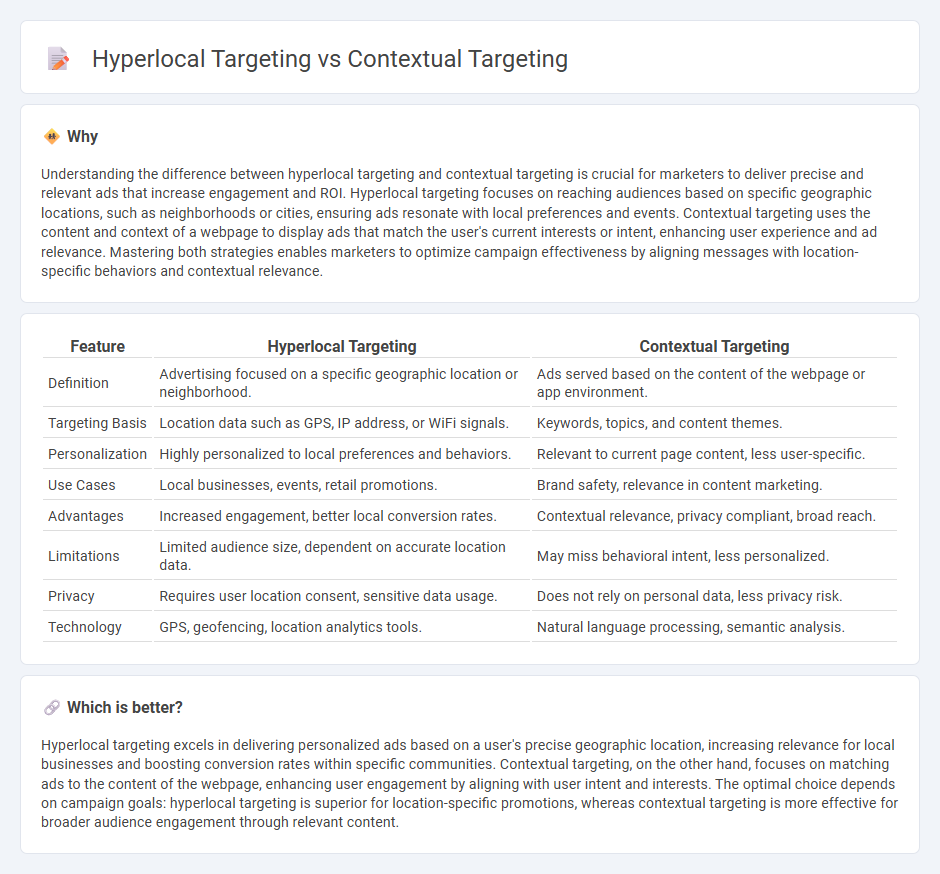
Hyperlocal targeting focuses on reaching consumers within a very specific geographic area, leveraging location data to deliver highly relevant ads based on real-time surroundings and local behaviors. Contextual targeting, on the other hand, places ads aligned with the content and context of a webpage, ensuring messages resonate with the audience's current interests without relying on personal data. Explore more to understand how these strategies can boost your marketing ROI effectively.
Why it is important
Understanding the difference between hyperlocal targeting and contextual targeting is crucial for marketers to deliver precise and relevant ads that increase engagement and ROI. Hyperlocal targeting focuses on reaching audiences based on specific geographic locations, such as neighborhoods or cities, ensuring ads resonate with local preferences and events. Contextual targeting uses the content and context of a webpage to display ads that match the user's current interests or intent, enhancing user experience and ad relevance. Mastering both strategies enables marketers to optimize campaign effectiveness by aligning messages with location-specific behaviors and contextual relevance.
Comparison Table
| Feature | Hyperlocal Targeting | Contextual Targeting |
|---|---|---|
| Definition | Advertising focused on a specific geographic location or neighborhood. | Ads served based on the content of the webpage or app environment. |
| Targeting Basis | Location data such as GPS, IP address, or WiFi signals. | Keywords, topics, and content themes. |
| Personalization | Highly personalized to local preferences and behaviors. | Relevant to current page content, less user-specific. |
| Use Cases | Local businesses, events, retail promotions. | Brand safety, relevance in content marketing. |
| Advantages | Increased engagement, better local conversion rates. | Contextual relevance, privacy compliant, broad reach. |
| Limitations | Limited audience size, dependent on accurate location data. | May miss behavioral intent, less personalized. |
| Privacy | Requires user location consent, sensitive data usage. | Does not rely on personal data, less privacy risk. |
| Technology | GPS, geofencing, location analytics tools. | Natural language processing, semantic analysis. |
Which is better?
Hyperlocal targeting excels in delivering personalized ads based on a user's precise geographic location, increasing relevance for local businesses and boosting conversion rates within specific communities. Contextual targeting, on the other hand, focuses on matching ads to the content of the webpage, enhancing user engagement by aligning with user intent and interests. The optimal choice depends on campaign goals: hyperlocal targeting is superior for location-specific promotions, whereas contextual targeting is more effective for broader audience engagement through relevant content.
Connection
Hyperlocal targeting and contextual targeting are connected through their focus on delivering highly relevant advertisements based on specific user environments and immediate surroundings. Hyperlocal targeting leverages geographic data to reach consumers within a narrowly defined area, while contextual targeting aligns ads with the content or context a user is engaging with, enhancing relevance and engagement. Combining these strategies increases precision in marketing campaigns, improving conversion rates by addressing both location relevance and thematic content alignment.
Key Terms
Relevance
Contextual targeting delivers ads based on the content of a website or app, ensuring relevance by matching audience interests and current browsing context. Hyperlocal targeting focuses on geographic precision, serving ads to users within a specific radius or neighborhood to increase local relevance and engagement. Explore the benefits and use cases of both strategies to optimize ad relevance in your campaigns.
Geolocation
Contextual targeting uses geolocation to serve ads relevant to the content or environment of a user's location, enhancing relevance without relying on personal data. Hyperlocal targeting leverages precise geolocation data, often down to the neighborhood or street level, to reach audiences in specific physical areas with highly customized messaging. Explore the benefits and implementation strategies of both geolocation-based targeting methods to maximize your marketing impact.
Personalization
Contextual targeting delivers personalized ads by analyzing the content a user is engaging with, ensuring relevance without relying on personal data. Hyperlocal targeting enhances personalization by focusing on precise geographic locations, tailoring ads to local preferences and behaviors. Explore how combining these strategies can optimize your marketing effectiveness.
Source and External Links
What is Contextual Advertising? Why is it Important? - Contextual targeting displays ads based on the current page's content--such as text, images, and media--using automated systems to match advertising to relevant themes or keywords in real time.
Contextual Advertising: What it is, how it works, and why to use it - Advertisers select targeting parameters like keywords, topics, negative keywords, location, and language to ensure ads appear alongside content that aligns with their campaign goals, enabling both broad and highly specific placements.
What is Contextual Targeting? - Contextual targeting allows advertisers to reach audiences by placing ads in environments related to specific interests, events, or topics, using advanced AI and natural language processing for deeper content classification without relying on third-party cookies.
 dowidth.com
dowidth.com